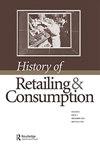Between aesthetics and a culture of decency. A comparative analysis of the vocabularies of consumption on the secondary markets of eighteenth-century Amsterdam and Antwerp
Q2 Arts and Humanities
引用次数: 0
Abstract
While detailed accounts of ownership patterns of material culture buttress major narratives on the critical consumer transitions of the late early modern era, still surprisingly little is known about the specific consumer mentalities that went along with the rapidly expanding empire of goods. On the basis of newspaper advertisements for auctions of household estates in Amsterdam and Antwerp, this contribution maps the language of consumption on the high-end secondary markets. Unsurprisingly the language of consumption in both (former) commercial metropoles evolved as the eighteenth century progressed, with product qualities such as ‘modern’ gaining in prominence. Yet, strange as it may seem, the boundaries between the mentalities of new, affordable luxuries and traditional old luxuries were by no means clear-cut. Moreover, in Antwerp as well as in Amsterdam, it was first and foremost the aesthetics of the rich material culture that were invoked to lure potential customers to an auction. Even though both societies were marked by a rather frugal and commercially oriented mentality, the elitist vocabulary of consumption relied heavily on ‘taste’ formation, hence contributing to the rising material inequalities that marked the eighteenth century.在美学和正派文化之间。18世纪阿姆斯特丹和安特卫普二级市场消费词汇的比较分析
虽然对物质文化所有权模式的详细描述支撑了现代晚期早期关键消费者转变的主要叙述,但令人惊讶的是,人们对伴随快速扩张的商品帝国而来的特定消费者心态知之甚少。在阿姆斯特丹和安特卫普的家庭地产拍卖报纸广告的基础上,这一贡献描绘了高端二级市场的消费语言。不出所料,随着18世纪的发展,这两个(前)商业大都市的消费语言也在不断发展,产品品质(如“modern”)越来越突出。然而,看起来很奇怪的是,新的,负担得起的奢侈品和传统的旧奢侈品之间的界限并不明确。此外,在安特卫普和阿姆斯特丹,吸引潜在客户参加拍卖的首要因素是丰富的物质文化美学。尽管这两个社会的特点都是相当节俭和以商业为导向的心态,但精英主义的消费词汇在很大程度上依赖于“品味”的形成,因此导致了18世纪物质不平等的加剧。
本文章由计算机程序翻译,如有差异,请以英文原文为准。
求助全文
约1分钟内获得全文
求助全文
来源期刊

History of Retailing and Consumption
Arts and Humanities-History
CiteScore
0.50
自引率
0.00%
发文量
3
 求助内容:
求助内容: 应助结果提醒方式:
应助结果提醒方式:


